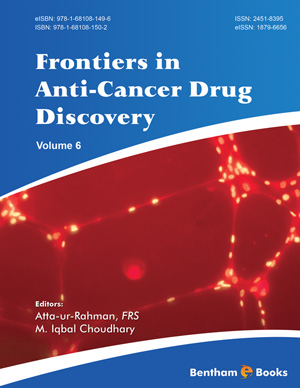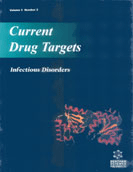Book Volume 6
Preface
Page: i-ii (2)
Author: Atta-ur-Rahman and M. Iqbal Choudhary
DOI: 10.2174/9781681081496115060001
List of Contributors
Page: iii-iv (2)
Author: Atta-ur-Rahman and M. Iqbal Choudhary
DOI: 10.2174/9781681081496115060002
Targeting Metabolic Reprogramming as an Anti- Cancer Strategy: Aiming at Monocarboxylate Transporters
Page: 3-65 (63)
Author: Céline Pinheiro, Filipa Morais-Santos, Sara Granja, Vera Miranda- Gonçalves, Julieta Afonso, Ricardo Amorim and Fátima Baltazar
DOI: 10.2174/9781681081496115060003
PDF Price: $30
Abstract
As the result of recent advances in the study of cancer biology, new hallmarks of cancer have emerged, including the reprogramming of energy metabolism. Indeed, it has been shown that cancer cells adjust their metabolism towards a high dependence on glycolysis for both energy and biosynthetic intermediate production. As a result of their high glycolytic rates, cancer cells produce high amounts of lactate as an end product. Therefore, to maintain their adapted metabolic phenotype, cancer cells, in addition to upregulating glucose transporters and other proteins involved in the glycolytic pathway, must also upregulate lactate transporters. In this context, monocarboxylate transporter isoforms 1 and 4 (MCT1 and MCT4) have emerged as important players in the maintenance of metabolic reprogramming of cancer cells: on one hand, they mediate lactate efflux from cancer cells, facilitating the maintenance of high glycolytic rates, and on the other hand, they also aid in the regulation of intracellular pH via a proton symport mechanism. Thus, MCTs appear to be promising targets in cancer therapy, especially in cancers with a hyperglycolytic and acid-resistant phenotype. Indeed, some in vitro and in vivo studies targeting MCT expression or function support the use of MCTs as therapeutic targets, and an MCT1-specific inhibitor developed by AstraZeneca is currently in clinical trials.
After an introductory section describing the metabolic reprogramming of cancer cells, this chapter will provide an up-to-date comprehensive review of recent achievements concerning the exploitation of MCTs as targets for anti-cancer therapy.
Oxidative Stress/FOXO Pathway is Enhanced in Hepatocellular Carcinoma by Interferon α-2b Treatment Favoring Cellular Apoptosis and Slowing Down Oncogenesis
Page: 66-90 (25)
Author: María Cristina Carrillo, Juan Pablo Parody and María Paula Ceballos
DOI: 10.2174/9781681081496115060004
PDF Price: $30
Abstract
The deregulation of Wnt/Frizzled-mediated signaling pathway has been suggested to play a central role in hepatic carcinogenesis. The impaired expression of the Wnt/β-catenin signaling constituents caused a deviant activation of the signaling in hepatocellular carcinoma (HCC). This conduces to the activation of the β-catenin/TCF dependent target genes, that control cell proliferation, cell cycle, apoptosis or motility. Disruption of this cascade has been shown to display anti-cancer properties in HCC.
Forkhead box O-class 3a (FoxO3a) is a member of the FOXO family of transcription factors, which is found in adult liver and regulates the expression of genes implied in apoptosis. FoxO3a is post-translationally regulated, in a negative way by PI3K/Akt and MAPK/Erk and in a positive way by oxidative stress/JNK pathways.
Data from our laboratory, allow us to propose a model in which Interferon α-2b (IFN α- 2b) offers a connection between Wnt signaling pathways and the oxidative stress/FOXO pathway. Treatment with IFN α-2b cause an oxidative stress that could fortified the relationship between FOXO and β-catenin and might inhibit the interaction with TCF. The impairment on the formation of β-catenin/TCF4/ complexes could have a decisive role in decelerating the oncogenesis process. The clinical implications of these results are significant, because β-catenin, TCF, and FOXO turn out as molecular targets for new treatments which can alter their interactions privileging programmed cell death or apoptosis over proliferation in patients that suffer a potential hepatocarcinogenic trauma.
Roles of HIF Family and ROS Homeostasis in Stem Cells and Cancer
Page: 91-109 (19)
Author: Kenly Wuputra, Ming-Ho Tsai, Kazunari K Yokoyama and Shigeo Saito
DOI: 10.2174/9781681081496115060005
Abstract
Oxygen homeostasis is needed for respiration and survival of mammalian cells and organisms. During conditions of hypoxia, cells activate the genes that help the adaptive response and the supply of oxygen to tissues. The hypoxia inducible factors (HIFs) as one of the critical transcription factors of hypoxia, may contribute to the maintenance of stem cells to show the self-renewal indefinitely, and express stemness genes in hypoxic stress environments (stem cell niches). Stem cells such as embryonic stem cells (ESCs) and induced pluripotent stem cells (iPSCs) decrease mitochondrial number and its activity, and induce anaerobic glycolysis under the hypoxia condition. Such a metabolic switch takes place in the early stage of the reprogramming process, and HIFs are necessary for this metabolic change. The similar hypoxic control is also evident in cancers. This chapter discusses the current knowledge about the role of oxidative and hypoxic stress in the cellreprogramming process and the implications of hypoxic regulation and ROS homeostasis in cancer progression and pluripotent stem cells.
Anthracyclines in Cancer Therapy: Past, Present Status and Future Prospects
Page: 110-136 (27)
Author: Lidia Mazur and Małgorzata Opydo-Chanek
DOI: 10.2174/9781681081496115060006
PDF Price: $30
Abstract
Anthracyclines rank among the most effective anticancer agents ever developed. Nevertheless, the clinical use of anthracyclines can be viewed as a sort of double-edged sword. On the one hand, anthracycline antibiotics are extensively used in conventional chemotherapy of solid tumors and hematological malignancies. On the other hand, the clinical efficacy of the drugs is limited by severe side effects, particularly cardiotoxicity, and the development of multiple mechanisms of cellular drug resistance. Therefore, several strategies for improving the efficacy of currently approved anthracyclines have moved along two medicinal chemistry lines, the development of both new analogs and cancer cell-targeted formulations. There is still necessary to develop these new strategies for improving the effectiveness and reducing side effects of the action of anthracyclines, respectively on cancer and normal cells. The current available knowledge on anthracyclines is based on a collection of the original published studies, conference abstracts, and relevant articles.
Terpenoids in Cancer: Molecular Targets and Clinical Perspectives
Page: 137-195 (59)
Author: Beatriz de las Heras and Sonsoles Hortelano
DOI: 10.2174/9781681081496115060007
PDF Price: $30
Abstract
Natural products and their derivatives are the most consistently successful source of drug leads. One of the most important families of natural compounds known for their medicinal value is the terpenoids. Terpenoids are found in higher plants, mosses, liverworts, algae and lichens, and also in insects, microbes or marine organisms; and have shown to exert anti-infective, anti-inflammatory, and anti-tumoral activities. In recent decades research activity into the clinical potential of this class of compounds in cancer has increased continuously. In the present review, molecular basis of the anti-tumoral action of terpenoids is presented with special emphasis on the latest progress in this field, including the recently elucidated findings about the potential of diterpenoids and triterpenoids as antitumoral agents. Furthermore, this review will summarize promising compounds that are being evaluated in clinical trials as potential chemotherapeutic agents.
Frontiers in Biological Therapies for Advanced Hepatocellular Carcinoma
Page: 196-217 (22)
Author: Liat Mlynarsky, Liane Rabinowich, Brian I. Carr and Oren Shibolet
DOI: 10.2174/9781681081496115060008
PDF Price: $30
Abstract
Hepatocellular carcinoma (HCC) is the fifth most common malignancy and the third commonest cause of tumor associated death worldwide. The incidence of HCC is increasing worldwide in both developing and developed countries. There are three potentially curative treatments for HCC: resection, liver transplantation and radiofrequency ablation. However, these are only suitable for patients meeting strict pre-defined criteria with compensated liver disease and small tumors. Patients who are not suitable for these therapies can be treated by loco-ablative or systemic therapies. Sorafenib, is the first and only systemic therapy that has been approved by regulatory agencies and demonstrated a survival benefit for patients with advanced HCC. In this chapter we review current therapy choices and focus on pipeline therapeutic options for advanced HCC, especially biological therapies.
Use of Magnetosomes of Biological Origin, By Magnetic Hyperthermia for the Treatment of Tumors
Page: 218-248 (31)
Author: Edouard Alphandéry
DOI: 10.2174/9781681081496115060009
PDF Price: $30
Abstract
This chapter describes a therapy for cancer using iron oxide nanoparticles, called magnetosomes, which are synthesized by magnetotactic bacteria. After intratumoral administration, magnetosomes extracted from magnetotactic bacteria are heated by applying an alternating magnetic field. The heat induces anti-tumor activity. This type of cancer therapy has essentially been developed using chemical nano-particles. Magnetosomes possess a series of advantages as compared with these chemical nanoparticles, such as a larger size and ferromagnetic behavior, which enable them to produce more heat and an arrangement in chains, which prevents aggregation. A preclinical proof of concept of the therapy, carried out on mice bearing MDA-MB231 breast tumors is presented and shows that it is possible to completely eradicate these tumors with the therapy. The latter French company called “Nanobacterie”, has been established in 2008 to develop the therapy.
Subject Index
Page: 249-258 (10)
Author: Atta-ur-Rahman and M. Iqbal Choudhary
DOI: 10.2174/9781681081496115060010
Introduction
Frontiers in Anti-Cancer Drug Discovery is an eBook series devoted to publishing the latest and the most important advances in Anti-Cancer drug design and discovery. Eminent scientists write contributions on all areas of rational drug design and drug discovery including medicinal chemistry, in-silico drug design, combinatorial chemistry, high-throughput screening, drug targets, recent important patents, and structure-activity relationships. The eBook series should prove to be of interest to all pharmaceutical scientists involved in research in Anti-Cancer drug design and discovery. Each volume is devoted to the major advances in Anti-Cancer drug design and discovery. The eBook series is essential reading to all scientists involved in drug design and discovery who wish to keep abreast of rapid and important developments in the field. The sixth volume of the series features chapters on several topics including: - Monocarboxylate transporters as anti-cancer drug targets - Interferon α-2b treatment for hepatocellular carcinoma - Anthracyclines in cancer therapy - Magnetosomes and tumor therapy …and more.






















